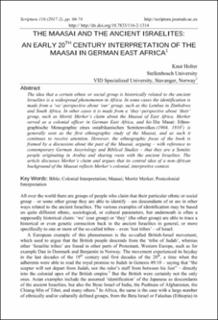| dc.contributor.author | Holter, Knut | |
| dc.date.accessioned | 2024-04-05T09:10:52Z | |
| dc.date.available | 2024-04-05T09:10:52Z | |
| dc.date.created | 2017-12-12T10:34:42Z | |
| dc.date.issued | 2017 | |
| dc.identifier.citation | Scriptura. 2017, 116 (2), 66-74. | en_US |
| dc.identifier.issn | 0254-1807 | |
| dc.identifier.uri | https://hdl.handle.net/11250/3125019 | |
| dc.description.abstract | The idea that a certain ethnic or social group is historically related to the ancient Israelites is a widespread phenomenon in Africa. In some cases the identification is made from a 'we'-perspective about 'our' group, such as the Lembas in Zimbabwe and South Africa. In other cases it is made from a 'they'-perspective about 'their' group, such as Moritz Merker's claim about the Maasai of East Africa. Merker served as a colonial officer in German East Africa, and his Die Masai: Ethnographische Monographie eines ostafrikanischen Semitenvolkes (1904, 19102) is generally seen as the first ethnographic study of the Maasai, and as such it continues to receive attention. However, the ethnographic focus of the book is framed by a discussion about the past of the Maasai, arguing—with reference to contemporary German Assyriology and Biblical Studies—that they are a Semitic people originating in Arabia and sharing roots with the ancient Israelites. The article discusses Merker's claim and argues that its central idea of a non-African background of the Maasai reflects Merker's colonial, interpretive context. | en_US |
| dc.language.iso | eng | en_US |
| dc.publisher | Stellenbosch University Library and Information Service | en_US |
| dc.rights | Attribution-NonCommercial-NoDerivatives 4.0 Internasjonal | * |
| dc.rights.uri | http://creativecommons.org/licenses/by-nc-nd/4.0/deed.no | * |
| dc.subject | Postkolonial teori og praksis | en_US |
| dc.subject | Postcolonial theory and practice | en_US |
| dc.subject | Maasai | en_US |
| dc.subject | Maasai | en_US |
| dc.subject | Bibelen. GT | en_US |
| dc.subject | Bible. OT | en_US |
| dc.title | The Maasai and the ancient Israelites : an early 20th century interpretation of the Maasai in East Africa | en_US |
| dc.type | Peer reviewed | en_US |
| dc.type | Journal article | en_US |
| dc.description.version | publishedVersion | en_US |
| dc.rights.holder | Copyright © 2024 Scriptura | en_US |
| dc.subject.nsi | VDP::Teologi: 151 | en_US |
| dc.subject.nsi | VDP::Theology: 151 | en_US |
| dc.subject.nsi | VDP::Teologi: 151 | en_US |
| dc.subject.nsi | VDP::Theology: 151 | en_US |
| dc.source.pagenumber | 66-74 | en_US |
| dc.source.volume | 116 | en_US |
| dc.source.journal | Scriptura | en_US |
| dc.source.issue | 2 | en_US |
| dc.identifier.doi | 10.7833/116-2-1314 | |
| dc.identifier.cristin | 1526115 | |
| dc.relation.project | Norges forskningsråd: 230625 | en_US |
| cristin.ispublished | true | |
| cristin.fulltext | original | |
| cristin.qualitycode | 1 | |

